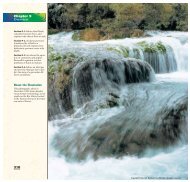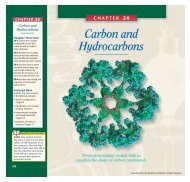Physical Characteristics of Gases
Physical Characteristics of Gases
Physical Characteristics of Gases
You also want an ePaper? Increase the reach of your titles
YUMPU automatically turns print PDFs into web optimized ePapers that Google loves.
2 PLAN<br />
3 COMPUTE<br />
4 EVALUATE<br />
Gay-Lussac’s Law: Pressure-<br />
Temperature Relationship<br />
You have just learned about the quantitative relationship between volume<br />
and temperature at constant pressure. What would you predict<br />
about the relationship between pressure and temperature at constant<br />
volume? You have seen that pressure is the result <strong>of</strong> collisions <strong>of</strong> molecules<br />
with container walls. The energy and frequency <strong>of</strong> collisions<br />
depend on the average kinetic energy <strong>of</strong> molecules, which depends on<br />
temperature. For a fixed quantity <strong>of</strong> gas at constant volume, the pressure<br />
should be directly proportional to the Kelvin temperature, which<br />
depends directly on average kinetic energy.<br />
That prediction turns out to be correct. For every kelvin <strong>of</strong> temperature<br />
change, the pressure <strong>of</strong> a confined gas changes by 1/273 <strong>of</strong> the pressure<br />
at 0°C. Joseph Gay-Lussac is given credit for recognizing this in<br />
1802. The data plotted in Figure 10-13 illustrate Gay-Lussac’s law: The<br />
pressure <strong>of</strong> a fixed mass <strong>of</strong> gas at constant volume varies directly with the<br />
Kelvin temperature. Mathematically, Gay-Lussac’s law is expressed as<br />
follows.<br />
PRACTICE<br />
P<br />
P = kT or = k<br />
T<br />
Copyright © by Holt, Rinehart and Winston. All rights reserved.<br />
Because the gas remains at constant pressure, an increase in temperature will cause an<br />
increase in volume. To obtain V 2 , rearrange the equation for Charles’s law.<br />
V1T2 V2 =<br />
Substitute values for V 1 , T 1 , and T 2 to obtain the new volume, V 2 .<br />
V1T2 (752 mL Ne)(323 K)<br />
V2 = = = 815 mL Ne<br />
298 K<br />
T 1<br />
As expected, the volume <strong>of</strong> the gas increases as the temperature increases. Units cancel to<br />
yield milliliters, as desired. The answer contains the appropriate number <strong>of</strong> significant figures.<br />
It is also reasonably close to an estimated value <strong>of</strong> 812, calculated as (750 × 325)/300.<br />
1. A helium-filled balloon has a volume <strong>of</strong> 2.75 L at 20.°C. The volume<br />
<strong>of</strong> the balloon decreases to 2.46 L after it is placed outside<br />
on a cold day. What is the outside temperature in K? in °C?<br />
2. A gas at 65°C occupies 4.22 L. At what Celsius temperature will<br />
the volume be 3.87 L, assuming the same pressure?<br />
T 1<br />
Pressure vs.<br />
Temperature for a Gas<br />
at Constant Volume<br />
Pressure (atm)<br />
6.0<br />
5.0<br />
4.0<br />
3.0<br />
2.0<br />
1.0<br />
Answer<br />
262 K, or −11°C<br />
Answer<br />
37°C<br />
0<br />
0 100 200 300 400 500<br />
Temperature (K)<br />
FIGURE 10-13 This graph shows<br />
that gas pressure varies directly with<br />
Kelvin temperature at constant<br />
volume.<br />
PHYSICAL CHARACTERISTICS OF GASES 319<br />
ADDITIONAL<br />
SAMPLE<br />
PROBLEMS<br />
SECTION 10-3<br />
Assume constant pressure in each<br />
<strong>of</strong> the following problems:<br />
10-3 A balloon filled with oxygen<br />
gas occupies a volume <strong>of</strong> 5.5 L at<br />
25°C. What volume will the gas<br />
occupy at 100.°C?<br />
Ans. 6.9 L<br />
10-3 A sample <strong>of</strong> nitrogen gas is<br />
contained in a piston with a freely<br />
moving cylinder. At 0.0°C, the volume<br />
<strong>of</strong> the gas is 375 mL. To what<br />
temperature must the gas be heated<br />
to occupy a volume <strong>of</strong> 500. mL?<br />
Ans. 91°C<br />
✔Teaching<br />
Tip<br />
Remind students that temperature<br />
calculations with the gas laws must<br />
always be done with absolute temperatures<br />
(in K); the temperature can<br />
then be converted to other desired<br />
units, such as degrees Celsius (°C).<br />
Class Discussion<br />
Ask students what happens to the<br />
pressure in a tire as an automobile<br />
is driven 100 km on a hot day<br />
(assume constant volume). Discuss<br />
the heating that takes place in the<br />
tire as a result <strong>of</strong> friction between<br />
the tire and the highway, and the<br />
increase in pressure that results<br />
because <strong>of</strong> more rapidly moving<br />
air molecules.<br />
319

















